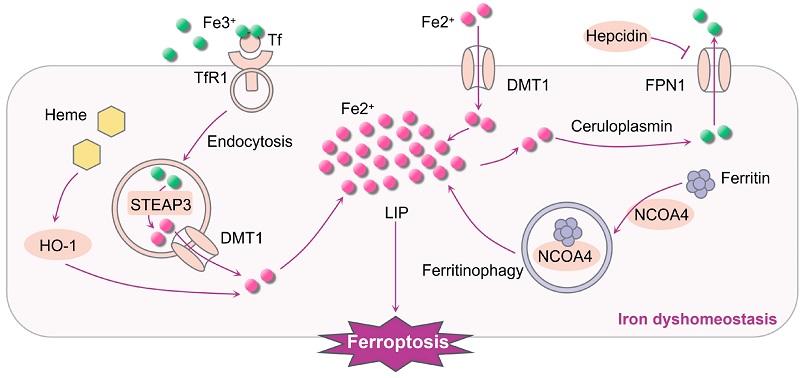Nikhil Prasad Fact checked by:Thailand Medical News Team Jun 20, 2024 1 year, 5 months, 15 hours, 47 minutes ago
Medical News: Neuropathic pain, a debilitating condition resulting from damage to the nervous system, affects millions worldwide. Despite advancements in pain management, understanding the intricate mechanisms behind this type of pain remains a challenge. Recent research by scientists from Gannan Medical University, Ganzhou-China that is covered in this
Medical News report, sheds light on the roles of neuroinflammation, iron regulation, and specific receptors in the development and persistence of neuropathic pain.
 Neuropathic Pain - The Role of Inflammation, Iron, and Receptors
Iron dyshomeostasis implicated in ferroptosis. Fe2+ is released through Tf degradation, ferritinophagy, or heme degradation. DMTl mediates the transport of extracellular free Fe2+ into the cell. The rise in unbound Fe2+ within the cell creates a pool of easily accessible iron. The cell releases Fe3+ to the exterior via FPNl. Furthermore, the breakdown of heme and the process of ferritinophagy mediated by nuclear receptor coactivator 4 (NCOA4) can raise the LIP, making cells more susceptible to ferroptosis via the Fenton reaction.
Understanding Neuropathic Pain
Neuropathic Pain - The Role of Inflammation, Iron, and Receptors
Iron dyshomeostasis implicated in ferroptosis. Fe2+ is released through Tf degradation, ferritinophagy, or heme degradation. DMTl mediates the transport of extracellular free Fe2+ into the cell. The rise in unbound Fe2+ within the cell creates a pool of easily accessible iron. The cell releases Fe3+ to the exterior via FPNl. Furthermore, the breakdown of heme and the process of ferritinophagy mediated by nuclear receptor coactivator 4 (NCOA4) can raise the LIP, making cells more susceptible to ferroptosis via the Fenton reaction.
Understanding Neuropathic Pain
Neuropathic pain arises from lesions or diseases affecting the somatosensory system. Unlike typical pain, it can cause heightened sensitivity to painful stimuli (hyperalgesia) or pain from normally non-painful stimuli (allodynia). This condition impacts 6.9% to 10% of the global population, significantly reducing the quality of life and imposing a burden on healthcare systems.
Neuroinflammation: The Silent Agitator
Neuroinflammation plays a crucial role in the development of neuropathic pain. It involves an inflammatory response in the central nervous system (CNS), primarily driven by microglia, the brain's resident immune cells. Microglia can switch between pro-inflammatory (M1) and anti-inflammatory (M2) states. In neuropathic pain, M1 microglia dominate, releasing substances that increase inflammation and pain sensitivity.
The Role of Microglia
Microglia constantly survey the CNS, ready to respond to disturbances. When activated by injury or disease, they transform, predominantly into the M1 state, releasing pro-inflammatory substances like TNF-α and IL-1β. These substances amplify pain by sensitizing nerve cells. Conversely, M2 microglia release anti-inflammatory factors, aiding in tissue repair and reducing pain.
Iron and Ferroptosis: A Deadly Duo
Ferroptosis, a type of cell death dependent on iron, is intricately linked to neuropathic pain. Iron dyshomeostasis, or imbalance, within cells can lead to the production of harmful reactive oxygen species (ROS), triggering ferroptosis. In the CNS, iron overload in microglia exacerbates neuroinflammation and pain.
Mechanisms of Ferroptosis
Iron accumulation disrupts cellular balance, leading to li
pid peroxidation and cell death. Key proteins like divalent metal transporter 1 (DMT1) and ferroportin-1 (FPN1) regulate iron levels. When these proteins malfunction, iron builds up, promoting ferroptosis. This process is further aggravated by neuroinflammation, creating a vicious cycle.
α7 Nicotinic Acetylcholine Receptor (α7nAChR): A Potential Target
The α7nAChR, a receptor found abundantly in the CNS, emerges as a potential therapeutic target. Activation of this receptor can reduce neuroinflammation by promoting the transition of microglia from the pro-inflammatory M1 state to the anti-inflammatory M2 state. This shift can alleviate neuropathic pain by reducing the release of inflammatory substances.
Biochemical Features of α7nAChR
The α7nAChR is unique due to its high calcium permeability and rapid response to activation. It facilitates neurotransmitter release and enhances synaptic plasticity, crucial for pain modulation. By influencing calcium levels and signaling pathways, α7nAChR plays a significant role in controlling inflammation and pain.
Therapeutic Implications
Targeting α7nAChR could offer new avenues for treating neuropathic pain. By activating this receptor, it may be possible to suppress neuroinflammation and ferroptosis, thus reducing pain. Additionally, regulating iron homeostasis and preventing iron overload in microglia could further alleviate pain symptoms.
Future Directions
Research into the interplay between α7nAChR, ferroptosis, and neuroinflammation is still in its early stages. However, the potential for developing new treatments based on these mechanisms is promising. Further studies are needed to fully understand these relationships and develop effective therapies for neuropathic pain.
Conclusion
Neuropathic pain remains a complex and challenging condition to treat. Recent discoveries highlight the significant roles of neuroinflammation, iron regulation, and α7nAChR in its development. By targeting these mechanisms, new and more effective treatments could emerge, offering hope to those affected by this debilitating condition. Continued research is essential to unlock the full potential of these findings and improve pain management strategies.
The study findings were published in the peer reviewed International Journal of Molecular Sciences.
https://www.mdpi.com/1422-0067/25/12/6716
For the latest on Neuropathic Pain, keep on logging to Thailand
Medical News.
Read Also:
https://www.thailandmedical.news/news/tens-therapy-shows-promise-for-long-covid-pain-relief
https://www.thailandmedical.news/news/breaking-doctor-from-uc-san-diego-warns-of-new-covid-19-manifestations-such-as-dermatomyositis-muscular-pains-and-alerts-about-lung-fibrosis
